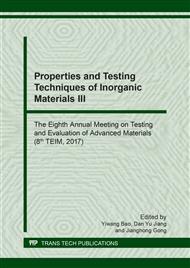[1]
Z.D. Lu, M.S. Song, Progress of research and development of carbon refractory material used in long campaign technology of blast furnace, WISCO TECHNOLOGY, 50 (2012) 58-62.
Google Scholar
[2]
H.B. Zuo, C. Wang, J.L. Zhang, et al., Application status and important technical indexes of BF hearth refractory, Iron and Steel, 50 (2015) 1-6.
Google Scholar
[3]
Z.J. Liu, J.L. Zhang, H.B. Zuo, and T.J. Yang, Recent progress on long service life design of Chinese blast furnace hearth, ISIJ Int., 52 (2012) 1713-1716.
DOI: 10.2355/isijinternational.52.1713
Google Scholar
[4]
K.X. Jiao, J.L. Zhang, Z.J. Liu, et al., Formation mechanism of the protective layer in a blast furnace hearth, Int. J. Miner., Metall. Mater., 22 (2015) 1017-1024.
DOI: 10.1007/s12613-015-1163-2
Google Scholar
[5]
Y.W. Li, S.B. Sang, Y. W. Li, Optimization and forecast of thermal conductivity of electrically calcined anthracite based carbon block by support vector machine, Bull. Chin. Ceram. Soc., 34 (2015) 44-49.
Google Scholar
[6]
Y.W. Li, X.L. Chen, Y.B. Li, et al., Effect of Multiwalled Carbon Nanotubes on the Thermal Conductivity and Porosity Characteristics of Blast Furnace Carbon Refractories, Metall. Mater. Trans. A, 41 (2010) 2383-2388.
DOI: 10.1007/s11661-010-0300-9
Google Scholar
[7]
X.L. Chen, Y.W. Li, Y.B. Li, et al., Effect of Reactive-Al2O3 Addition on the Pore Size Distribution and Thermal Conductivity of Carbon Blocks for Blast Furnace, Adv. Mater. Res., 97-101 (2010) 453-456.
DOI: 10.4028/www.scientific.net/amr.97-101.453
Google Scholar
[8]
X.L. Chen, Y.W. Li, Y.B. Li, et al., Properties and microstructures of blast furnace carbon refractories with Al additions, Ironmaking & Steelmaking, 37(2010) 398-406.
DOI: 10.1179/030192310x12646889255825
Google Scholar
[9]
Y.W. Li, X.L Chen, S.B Sang, et al., Microstructures and Properties of Carbon Refractories for Blast Furnaces with SiO2 and Al Additions, Metall. Mater. Trans. A, 41(2010) 2085-(2092).
DOI: 10.1007/s11661-010-0242-2
Google Scholar
[10]
H.B. Fan, Y.W. Li, S.B. Sang, Microstructures and mechanical properties of Al2O3-C refractories with silicon additive using different carbon sources, Mater. Sci. Eng. A, 528 (2011) 3177-3185.
DOI: 10.1016/j.msea.2010.12.066
Google Scholar
[11]
Q.H. Wang, Y.W. Li, S.B. Sang, et al., Effect of the reactivity and porous structure of expanded graphite (EG) on microstructure and properties of Al2O3-C refractories, J. Alloys Compd., 645 (2015) 388-397.
DOI: 10.1016/j.jallcom.2015.05.124
Google Scholar
[12]
C.G. Aneziris, J. Hubalkova, R. Barabas, Microstructure evaluation of MgO-C refractories with TiO2- and Al-additions, J. Eur. Ceram. Soc., 27 (2007) 73-78.
Google Scholar
[13]
J. Ziebro, I. Łukasiewicz, B. Grzmil, et al., Synthesis of nickel nano capsules and carbon nano- tubes via methane CVD, J.Alloys Compd., 485 (2009) 695-700.
DOI: 10.1016/j.jallcom.2009.06.039
Google Scholar
[14]
L.L. Cao, Z.Q. Li, G.L. Fan, et al., The growth of carbon nanotubes in aluminum powders by the catalytic pyrolysis of polyethylene glycol, Carbon, 50 (2012) 1057-1062.
DOI: 10.1016/j.carbon.2011.10.011
Google Scholar
[15]
D. Xing, X.C. Li, B.Q. Zhu, et al., In-situ synthesis mechanism of plate-shaped β-Sialon and its effect on Al2O3-C refractory properties, Ceram. Int., 41 (2015) 14376-14382.
DOI: 10.1016/j.ceramint.2015.07.071
Google Scholar
[16]
P.G. Boswell, On the calculation of activation energies using a modified Kissinger method, J. Therm. Anal., 18 (1980) 353-358.
Google Scholar
[17]
M.J. Starink, A new method for the derivation of activation energies from experiments performed at constant heating rate,Thermochim. Acta, 288 (1996) 97-104.
DOI: 10.1016/s0040-6031(96)03053-5
Google Scholar
[18]
J.G. Zhao, Q.G. Guo, J.L. Shi, et al., Carbon nanotube growth in the pores of expanded graphite by chemical vapor deposition, Carbon, 47 (2009) 1747-1751.
DOI: 10.1016/j.carbon.2009.02.028
Google Scholar


